Can you eat Chicken and Eggs during Chicken pox?
April 3, 2017 by admin
Filed under Tips for Ayurveda
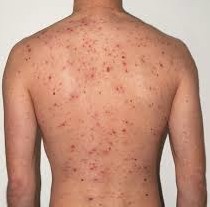 Chicken pox is caused by the varicella-zoster virus. Chicken pox is highly contagious disease and generally affects children. When a person is infected with chicken pox you will see a breakout of rashes all over the body which appears in the form of pus filled boils.
Chicken pox is caused by the varicella-zoster virus. Chicken pox is highly contagious disease and generally affects children. When a person is infected with chicken pox you will see a breakout of rashes all over the body which appears in the form of pus filled boils.
The person infected with chicken pox will have low appetite. The first 2 days the child will feel weak and fatigued. He’ll not feel like eating much quantity of food and will rely on liquid diet. After the fourth day the child will improve on food intake.
The number of blisters will keep increasing as days progress. You will see fresh ones near the genitals, palms, feet and sole, mouth and scalp area too.
The most important question that will come to your mind is with regard to the kind of food your child can and cannot consume. Make sure that his/her diet includes foods that are rich in nutrients, vitamins and minerals. Importance is placed on eating fruits and vegetables.
Foods to avoid during Chicken pox
- In India people avoid eating non-vegetarian foods like chicken, meat, fish and eggs etc. Considered to be hot and aggravate the boils.
- Quantity of salt is reduced to avoid itching. Ghee addition, oily foods are avoided to ensure proper digestion. Spicy foods are totally avoided to minimize itching and easy digestion.
- Avoid citric fruits and juices as it may cause itching.
- Avoid wheat flour, by-products of wheat-All purpose flour (maida), bread as it will increase heat in the body.
- Do not use dhals -tur dhal, moong dhal, chick pea (chana) etc as it can cause pus in the boils. Usually potato is also avoided along with masalas while cooking vegetable curries.
Foods to eat during Chicken pox
- Consume fruits and vegetables in plenty. Banana, Water melon, berries, guava are ideal. Avoid citric fruits as it may cause itching.
- Eat curds, drink butter milk to cool the body.
- Serve porridge with coconut chutney ( Thenga chammandhi Recipe; Grind ½ cup grated raw coconut, shallots:5 (or) ½ an onion, small piece of tamarind,1/2 tsp of grated ginger, ½ tsp chilli powder, 2-3 curry leaves, salt: to taste, Grind all ingredients with 3 tsp of water).
- Use non stick pan to make dosa, appam. Puttu is a steam cooked rice recipe, ideal during chicken pox. Mix with yellow color small banana.
- In South India people consume rice in the form of puffed rice or flattened rice mixed with chopped banana or fruits.
Do’s during Chicken pox
- Drink lots and lots of water and keep body hydrated.
- Spread neem leaves on the bed cover such that the patient’s skin will be in contact with the leaves.
- Use neem leaves to avoid itching sensation. Gently fan the spots with neem fronds (tender leaves) if you feel itchy. The essential oils from neem leaves will provide soothing feeling.
- If itching is severe, mix 1 tspn of baking soda in 2 glasses of water and then sponge the body with this solution.
- After the rashes have dried, a lengthy bath can be planned for your child. Heat water in which neem leaves and fresh turmeric has been added I day in advance. The next day heat the same water and then bath. This water has medicinal properties with antibacterial properties as well.
- Wear loose, light colored cotton clothes. Also recommended to use light colored bed spreads.
- Doctors advise to apply Calamine lotion over the boils to get relief from itching. Gives cooling affect.
Dont’s during Chicken pox
- Do not scratch vigorously and break the boils. Water will ooze and infection will spread further. It will also lead to ugly scars.
- Do not leave the person unattended during the initial 3 days. The weakness will be severe and the patient will faint with exhaustion due to fever and body pains.
- Do not send the infected person out of the house-school, play school or work as it is contagious.
- Do not bathe till all the boils and rashes have dried. Skin should not come in contact with water. Avoid medicated soaps.
The Ayurvedic name for chicken pox is Laghu Masurika. Generally speaking, the disease would take between 10 and 15 days to run its course. Ayurveda recommends fanning with neem leaves, application of neem paste, honey on the blisters. Oatmeal soak is another option for sponging the body.
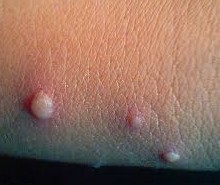 Chicken pox is a contagious disease and can spread quite easily from person to person. Doctors too inform that the chicken pox virus spreads when the rashes starts falling. The most contagious time is during the initial 2 to 5 days of the illness. The chicken pox virus may spread through contact with infected droplets that are released into the air while coughing and sneezing.
Chicken pox is a contagious disease and can spread quite easily from person to person. Doctors too inform that the chicken pox virus spreads when the rashes starts falling. The most contagious time is during the initial 2 to 5 days of the illness. The chicken pox virus may spread through contact with infected droplets that are released into the air while coughing and sneezing.
As chicken pox is caused by a virus, antibiotics are not helpful. Usually treatment for chicken pox involves topical applications in order to reduce discomfort caused by the rash. Medication may also be given to reduce fever and pains.
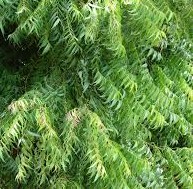 Neem leaves play a key role in Ayurvedic treatment for chicken pox. Neem has antiviral properties and hence combats the varicella zoster virus. It quickens the drying of the fluid in the blisters, and reduces the itchy and scratchy sensation that the chicken pox blisters cause.
Neem leaves play a key role in Ayurvedic treatment for chicken pox. Neem has antiviral properties and hence combats the varicella zoster virus. It quickens the drying of the fluid in the blisters, and reduces the itchy and scratchy sensation that the chicken pox blisters cause.
Massive cleaning is to be done in the home after the infected person has had bath and no further symptoms are seen in the other family members.
There is another condition called shingles which is another form of chicken pox affected by the nerves. Read more in upcoming article.
Please add a comment and, if you like the post, feel free to share it with your friends.
11 RECOMMENDATIONS TO PREVENT DIABETES NATURALLY
January 28, 2013 by admin
Filed under Tips for Ayurveda
Diabetes is spreading all over the world. People of all ages are having diabetes. This is basically due to change in food habits, lifestyle of people at work, lack of physical labour, severe pressure of mental work and stress, fast food culture. The amount of insulin produced by pancreas is reduced in quantity , thereby leading to the increase of sugar in blood . Excess sugar gets eliminated from the body through urine. Diabetes is a life time health problem, it can be controlled by medication and dietary regulations.
There are 2 major types of diabetes mellitus: they are Insulin dependent Juvenile Diabetes Type I in which the body is unable to produce insulin and Non Insulin Dependent Adult Onset Diabetes Type II in which the pancreas produces insulin, but it is insufficient for reducing the blood glucose to normal levels.
Best home remedies for preventing diabetes naturally as advised in Ayurveda is:
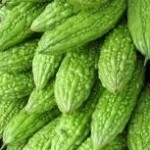 1) Consume Bitter gourd or Bitter melon known as ‘Karela’ in Hindi. You can have bitter gourd in any form raw juice or steamed with salt , onion and green chilly. It is good to reduce blood sugar levels. The blood sugar lowering action of the vegetable in the form of juice or cooked vegetable has been clearly established in both experimental and clinical studies. Bitter melon is composed of several compounds with confirmed anti-diabetic properties
1) Consume Bitter gourd or Bitter melon known as ‘Karela’ in Hindi. You can have bitter gourd in any form raw juice or steamed with salt , onion and green chilly. It is good to reduce blood sugar levels. The blood sugar lowering action of the vegetable in the form of juice or cooked vegetable has been clearly established in both experimental and clinical studies. Bitter melon is composed of several compounds with confirmed anti-diabetic properties
2) Consume Indian black berry or black Jamun in any form. The fruit is very good to reduce sugar levels. The seeds can be dried and powdered too.
3) Fenugreek or Methi seeds is a common home remedy for Diabetes. Add 2 teaspoons of powdered Methi seeds in milk and consume it daily
4) Curry leaves or Kadi patta in Hindi, taken early in the morning is also very good for reducing diabetes obtained due to heredity factors. It also cures diabetes due to obesity.
5) A spoonful of Cinnamon , Dalchini in Hindi helps reduce blood sugar levels. Cinnamon has a compound called Methylhydroxy chalcone polymer. It helps cells absorb glucose faster and converts it to energy so your blood sugar levels remain low.
6) Kidney beans known as lobia in Hindi have a greater fiber content and are rich in carbohydrates. Soak it for few hours and then cook it. Very good to reduce blood sugar levels.
7) Use onion and garlic liberally. Both are now known to have a significant ability to lower blood sugar. You can consume few pods of garlic and few slices of onion raw for better results.
8) Amla,known as goose berryhas high vitamin C content and is effective in controlling diabetes. A tablespoon of amla juice, mixed with a cup of fresh bitter-gourd juice, taken daily for two months will secrete the pancreas and enable it to secrete insulin.
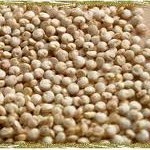 9) Quinao (pronounced as Keen-wah) known as bathua in Hindi is also low in fat, has fiber, and is a good source for manganese which is good for carbohydrate metabolism and helps regulate blood sugars.
9) Quinao (pronounced as Keen-wah) known as bathua in Hindi is also low in fat, has fiber, and is a good source for manganese which is good for carbohydrate metabolism and helps regulate blood sugars.
10) Take ten tulsi leaves, ten neem leaves and ten belpatras with a glass of water early morning on an empty stomach. It will work wonders in keeping your sugar levels under control.
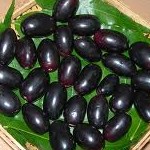 11) The leaves of Jamun have power to control conversion of starch into sugar and a good example of ayurvedic cure of diabetes.
11) The leaves of Jamun have power to control conversion of starch into sugar and a good example of ayurvedic cure of diabetes.
You need to combine exercise in addition to diet controls. Avoiding alcohol and quitting smoking are most advantageous for individuals with diabetes.
You can balance fruits and vegetables with your meals. Have Broccoli, zucchini, prunes, cantaloupes, grapefruit, apples, strawberries, black beans, pinto beans, kidney beans, spinach.
Fats slows the absorption of sugar into the bloodstream so it’s important we choose the right fats. Mono-unsaturated fats may help lower your risk for increased blood sugars. The best choices to use are Olive Oil, Coconut Oil, Nuts, Peanut Butter, Flaxseed Oil, Omega-3 rich fatty acids (like those found in most fishes and in walnuts) and Avacados.
Preferably have wheat rava , dhalia in Hindi as porridge or upma. Good meal at dinner time.
Have multiple meals in a day in small quantities. Precaution is better than cure. Keep a watchful eye on the food you take, hygiene practices to avoid health problems later.
HOW TO CONTROL HAIR LOSS – HOME REMEDIES AND TIPS
December 30, 2012 by admin
Filed under Tips for Ayurveda
Hair adds dimension to your personality. Black , lustrous hair is what all of us yearn for. In the recent times it is observed that hair loss is very common and people have started to be conscious on hair care.
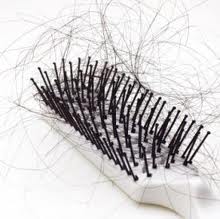 Reasons for Hair Loss
Reasons for Hair Loss
Hair is formed in tiny pockets in the skull known as follicles. The upgrowth from follicle is called the papilla. Papilla with the help of a specific group of cells that turn amino acids into keratin, produces hair. Keratin is a type of protein that makes hair. Higher the rate of production of keratin, more will be the hair growth. The rate of production, in turn, depends on the vital nutrients supplied through the diet of a person. If vitamins and other nutrients are provided in sufficient amounts, hair grows at normal rate but if there is a deficiency of vitamins and nutrients then no protein is formed which, on the one hand, stops the growth of hair and on the other hand makes the hair weak leading to hair loss and baldness. Therefore, one of the major reasons of hair loss is deficiency of nutrients. There are some other reasons for hair loss too.
- Lack of vitamin B6, folic acid, calcium etc.
- Stress
- Prolonged Illness
- Improper or irregular cleaning of hair
- Heredity
- Pollution; environmental hazards
- Application of chemicals on hair ( hair straightening, coloring, hair dyes etc.)
- Poor blood circulation
Home Remedies for Hair Loss
The best hair loss home remedy is to have a balanced diet and to keep the hair clean with proper hair care. Massage with some oils too leads to healthy hair and improved blood circulation. Some hair is lost everyday which is a natural process of hair growth and should not be a cause of any worry. However, if someone notices an abnormal falling of hair and worse even- baldness patches- s/he must immediately start natural treatment for hair loss that includes some herbal remedies for hair loss.
- After washing hair (as far as possible hair should be washed with cool water, hot water robs hair off its natural oil), rub the scalp with fingers till you feel some warmth in your fingers as well as scalp. This activates the sebaceous glands (that secrets oil for hair growth) and also improves blood circulation preventing any further hair loss.
- Boil some dry pieces of Indian gooseberry or Amla in coconut oil. Massage your hair with this preparation. It helps in strengthening hair.
- Take some fresh leaves of Amaranth (Amaranthus or ‘Chaulai-ka-saag’) and take out their juice after grinding them. Apply this juice on your hair. It helps in hair growth and makes them soft. Take Alfalfa (Medicago sativa or ‘Jaw’), carrot and lettuce in equal quantity and make them into juice. This juice is excellent hair loss remedy.
- Wash hair with the decoction of margosa leaves or ‘Neem’. It prevents hair loss and make them more black apart from cleaning hair by killing lice and other infesting insects.
- Take 250 grams of mustard oil and sixty grams of Hennaleaves or ‘Mehndi’ and boil them till the leaves get totally burnt. Filter the oil and massage the scalp regularly with this oil. It is a very good home remedy for preventing hair loss.
- Make a paste of fenugreek seeds and water. Apply on scalp and leave for about half an hour before washing it off. Do it regularly for one month to treat hair loss.
- Take honeyand egg yolk to make a mixture of both. Massage the scalp and hair with this preparation and leave for half an hour before washing.
- Take 100 grams each of Goose berry (amla), Sapindus Mucorosai (reetha), and Acacia Concinna (shikakai) and boil them in two liters of water till the liquid remains half in quantity. Use this home made shampoo to wash your hair. It is a good herbal remedy for hair loss.
- Mix Aloe Vera with Triphala. Triphala is a herbal powder consisting of equal parts of three Indian Herbs- Amla, Bibhitaki and Haritaki. Apply this mixture to hair regularly for 3-6 months. It helps in growth of new hair.
Also follow the below mentioned procedures for improving hair growth.
1. Regular Massaging with lukewarm Oils
To stimulate the hair follicles, regular massaging of the scalp with lukewarm oil helps .Hair growth deterrents like dandruff and fungal infections can be easily cured. Regular massaging increases the blood circulation in the scalp. It is also useful for lowering anxiety or stress that is often the underlying reason for thinning of hair. It increases formation of serum and hair growth. Recommended oils for 3 to 4 times-a-week massaging schedule includes coconut oil. You can alternate this with mustard oil. Keep the oil on for at least six hours before washing it off with a mild shampoo. Other oils that can be mixed with coconut oil in trace amounts for faster results include almond oil.
2. Natural Concoctions for Preventing Hair Loss
Coconut milk is among the richest sources of tissue-nourishing, plant derivatives. It is an excellent home remedy for keeping the hair soft without depending upon chemical formulations and regenerating dead hair follicles. You can also use a concoction of coconut oil mixed with half the amount of Amla oil. Just add a tsp of lemon juice to this mixture and you have an effective, dandruff-fighting and scalp-healing concoction that arrests receding hairline.
3. Nature’s Effective Hair-stimulating Juices
Wheatgrass juice is one of the most effective remedies against hair fall. It is known to decrease the shedding tendency of hair within a few weeks of regular intake. Aloe vera juice has a similar effect. However, aloe gel can be applied to the scalp too. This is helpful for preventing hair loss due to irritated, dry or infected scalp. After massaging the head with aloe gel, wash the hair with lukewarm water. This can be done twice, every week.
4. Very Effective Natural Therapies
You can make your own hair fall-preventing medicine at home by frying some fenugreek (methi) seeds in coconut oil. Strain this mixture and apply it in minimal amounts, rubbed gently into the hair roots. Alternatively, you can boil some henna leaves or curry leaves in mustard oil. After cooling and straining this preparation, add drops of it in your coconut oil container that you are using for regular massaging.
5. Homemade Pastes
You can wash the hair with a paste made from Neem leaves. This is particularly effective for hair loss caused due excessive build up of scalp oil or invasive skin infections. For restoring the alkaline balance of the scalp and preventing hair fall, you can follow this with washing the hair with apple cider vinegar. Other homemade pastes that can be very useful include a mixture prepared from adding honey and olive oil to some cinnamon (dalchini) powder. You can also grind hibiscus leaves to a paste and apply it to scalp. Leave it for 30 mins and wash your hair. This prevents formation of dandruff.
6. Arrest Hair Fall With your house hold preparations
Before washing your hair, apply the juice extracted from crushed coriander (dhania) leaves. You can also use a mixture of curd and gram flour (chana atta) that should be kept-on for at least an hour before bathing.







